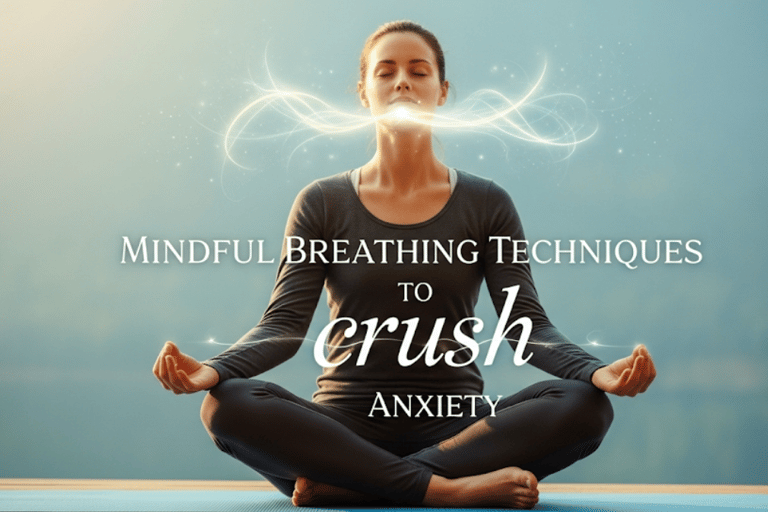Top 7 Mindful Breathing Techniques to Crush Anxiety Naturally
Discover 7 powerful mindful breathing techniques to naturally curb anxiety. From 4-7-8 breathing to Navy SEALs’ box breathing, these simple, evidence-based methods reduce stress, calm your mind, and restore control. Learn step-by-step guides to activate your body’s relaxation response and find peace anytime, anywhere. Start your anxiety-free journey today!
VerdantEase
8/13/20257 min read


Top 7 Mindful Breathing Techniques That Curb Anxiety Naturally
If you have ever experienced anxiety, it might feel like an elephant is sitting on your chest and there is no way to take a full breath. If you are one of the many whose heart rate increases, hands get a little sweatier, or is filled with a sense of dread… well, same. There are millions of people around the world dealing with anxiety on a daily basis, and trying to find that peace in nature is one way to go about doing it.
Well, there's some good news: One of the most effective tools to fight anxiety, you carry around with you at all times — your breath. Mindful breathing techniques have been used for centuries to help you relax, reduce stress, and soothe your anxious thoughts. These simple and easy ways will help you activate the natural relaxation response that your body has, slow down your heart rate, and help you regain control when anxiety falls from the sky.
In this post, I'll discuss 7 evidence-based breathing techniques to help you with your anxiety problems as naturally as possible. Simple and convenient, no tools are needed, and you can learn how to do it in no time whether you have a stressful day or are dealing with more severe anxiety episodes.
This Is Why Breathing Techniques Are Effective for Anxiety
Before discussing the different techniques you can use, let us first understand why breathing exercises are effective against anxiety.
When you feel anxious, your body goes into "fight or flight" mode, triggering your breath to become shallow and fast. This warns the brain that there is danger nearby and ultimately keeps your anxiety going.
Controlled breathing breaks this cycle by:
Activating the parasympathetic nervous system — your "rest and digest" state, which calms you down.
Lowering cortisol levels — reducing stress hormone secretion, regulating anxiety.
Boosting oxygen flow to your brain — improving mental clarity and reducing panic.
Helping ground you in the present moment — shifting attention from anxious thoughts while focusing on breathwork.
Giving you a sense of control — providing a resource that can boost confidence during tough times.
Breathing Pattern | Body Response | Anxiety Effect
Breathing Pattern
Body Response
Anxiety Effect
Quick, shallow
Activates stress response
Increases anxiety
Slow, deep
Activates relaxation response
Reduces anxiety
Controlled rhythm
Balances nervous system
Promotes calm
Method #1: 4-7-8 Breathing — The Reset Button for Your Body
The 4-7-8 breathing technique, developed by Dr. Andrew Weil, is known as a “natural tranquilizer” because of how quickly it can relieve anxiety. It relaxes and calms your whole nervous system in just a few minutes.
How to Practice 4-7-8 Breathing:
Comfortable Position – Sit or lay down flat with a straight back.
Put your tongue tip behind your upper front teeth.
Blow out all the air through your mouth with a whooshing sound.
Shut your mouth and slowly inhale through your nose for 4 counts.
Hold your breath for 7 counts.
Exhale with a whooshing sound through your mouth for a count of 8.
Repeat 3–4 times.
When to Use:
Before a big meeting or presentation.
Upon waking up feeling anxious.
Before bed to wind down.
During panic attacks.
For quick stress relief anytime.
Freebie Tip: If 4–7–8 feels too long, start with lower counts like 2-3-4 or 3-5-6 until you get used to it.
Method #2: Box Breathing — The Secret Weapon of Navy SEALs
Used by Navy SEALs, athletes, and first responders to remain calm under pressure, box breathing involves equal counts for inhale, hold, exhale, and hold.
Step-by-Step:
Sit upright with feet flat on the floor.
Push all the air out of your lungs.
Inhale through your nose for 4 counts.
Hold for 4 counts.
Exhale through your mouth for 4 counts.
Hold empty for 4 counts.
Continue for 5–10 rounds.
Why It Works:
Increases focus and concentration.
Predictable rhythm calms the mind.
Provides control in stressful situations.
Can be done anywhere, discreetly.
Visualization Tip: Imagine drawing a box in your mind — inhale going up, hold at the top, exhale going down, hold at the bottom.
Method #3: Belly Breathing — Back to Basics
When anxious, many people breathe from their chest rather than their diaphragm, worsening stress. Belly breathing (diaphragmatic breathing) restores deep, slow breathing from your core.
How to Do It:
Sit or lay down comfortably with shoulders relaxed.
Place one hand on your chest and one on your belly.
Inhale slowly through your nose so your belly rises (chest stays still).
Exhale slowly through pursed lips so your belly falls.
Make exhale longer than inhale.
Continue for 5–20 minutes.
Signs You’re Doing Belly Breathing Correctly
Your belly inflates and deflates like a balloon.
Your chest rises and falls only slightly.
You feel more at ease between each breath.
Over time, your breathing becomes deeper and fuller without effort.
Tension melts away from your neck and shoulders.
Common Mistakes to Avoid:
Forcing your breath — let it flow naturally.
Breathing too fast or too deeply at first.
Getting frustrated if you don’t feel results immediately.
Holding tension in shoulders or jaw.
Quitting too early — it takes practice!
Method #4: Coherent Breathing — Find Your Own Rhythm
Research shows that 5 breaths per minute is an ideal rate for reducing anxiety. Coherent breathing syncs your heart, mind, and emotions while promoting calm.
How to Practice:
Inhale through your nose for 4 seconds.
Exhale through your nose or mouth for 6 seconds.
Keep the rhythm consistent — no gaps between breaths.
Practice for 10–20 minutes per day.
Use a timer or app for guidance.
Benefits:
Boosts heart rate variability.
Balances your nervous system.
Naturally reduces blood pressure.
Improves emotional stability.
Builds long-term stress resilience.
Tech Tip: Apps like Breathe, Calm, or even a metronome can help you sustain the 6-second rhythm.
Method #5: Alternate Nostril Breathing — Ancient Wisdom for Modern Stress
Also called Nadi Shodhana in Sanskrit, this technique balances the brain’s hemispheres and soothes the nervous system.
How to Practice:
Sit comfortably with a straight spine.
Use your right thumb to close your right nostril.
Inhale through the left nostril for 4 counts.
Close your left nostril with your ring finger.
Exhale through the right nostril for 4 counts.
Inhale through the right nostril for 4 counts.
Close the right nostril, exhale through the left for 4 counts.
Repeat 5–10 times.
Why It Works:
Shifts focus away from racing thoughts.
Creates a meditative, calming state.
Balances the nervous system.
Promotes inner peace and centeredness.
Beginner Tip: If the finger positioning feels awkward, simply use one finger to gently block each nostril.


Method #6: Progressive Muscle Relaxation with Breathing
This method combines breath control with muscle tension and release to train your body to fully relax.
Step-by-Step:
Lie down in a quiet place.
Start with deep belly breaths.
Tense your toes and feet for 5 seconds while inhaling.
Exhale slowly, releasing all tension.
Move up to calves, thighs, glutes, abdomen, hands, arms, shoulders, and face.
End with whole-body tension for 5 seconds, then release completely.
Target Muscle Groups:
Toes, feet, calves, thighs, glutes.
Abdomen and lower back.
Hands, forearms, biceps, shoulders.
Jaw, eyes, forehead.
Extra Benefits:
Improves sleep quality.
Reduces chronic muscle tension.
Teaches your body to relax on demand.
Method #7: Counted Breathing — Your Personalized Calm
With counted breathing, you control the length of inhales and exhales to match your stress level.
Basic Method:
Choose a count — start with 4 in, 4 out.
Sit or lie down comfortably.
Inhale through your nose to a slow count of 4.
Exhale through your mouth to a slow count of 4.
Maintain a steady, relaxed rhythm.
Continue for 5–15 minutes.
Customization Ideas:
4 in, 6 out — mild stress (5 minutes).
4 in, 8 out — moderate anxiety (10 minutes).
3 in, 6 out — high anxiety (15 minutes).
Advanced Variations:
Triangle breathing: 4 in, 4 hold, 4 out.
Extended exhale: 4 in, 8 out.
Equal breathing: inhale and exhale same length.
Creating Your Daily Breathing Practice
Morning Routine (5–10 minutes):
Belly breathing for 2–3 minutes.
Practice one technique fully.
Set an intention to stay calm all day.
Midday Reset (2–5 minutes):
Box breathing during breaks.
Coherent breathing between meetings.
4-7-8 breathing before stressful moments.
Evening Wind-Down (10–15 minutes):
Progressive muscle relaxation.
Alternate nostril breathing.
Counted breathing before sleep.
Emergency Anxiety Kit:
Quick relief: 4-7-8 breathing (30 sec–2 min).
Moderate stress: Box breathing (5 minutes).
Best Practices for Breathing Exercises
Even 2–3 minutes a day can help.
Be patient — retraining breath takes time.
Practice daily for best results.
Do it at the same time each day.
Track which techniques help most.
Common Challenges & Solutions:
Forgetting: Set reminders or pair practice with a daily habit.
Feeling dizzy: Slow your breathing.
Mind wandering: Gently return focus to breath without judgment.
No results yet: Practice consistently for 2–3 weeks.
When to Seek Extra Help
Breathing techniques are powerful, but if you experience:
Panic attacks that don’t improve.
Anxiety disrupting daily life.
Physical symptoms (chest pain, dizziness).
Constant worry for months.
Avoiding daily activities.
Persistent insomnia.
Thoughts of self-harm.
→ Seek help from a mental health professional.
Breathing can work alongside therapy or medication, but never stop or change medication without your doctor’s advice.
Conclusion
Life does not have to be controlled by anxiety. These seven techniques are free, simple, and available anytime you need them. Start with just one today — even for a few minutes — and stay consistent. Over time, you may notice less stress, better sleep, and more confidence in handling challenges.
Take a deep breath — you’ve already started your journey toward natural anxiety relief.
Frequently Asked Questions
Q: How soon will breathing exercises work?
A: Some, like 4-7-8 breathing, work in minutes. Others, like coherent breathing, show best results after 2–3 weeks.
Q: Can I do these if I have asthma?
A: Speak with your doctor first. Gentle techniques may be safe, but avoid any that cause discomfort.
Q: Which is best for panic attacks?
A: 4-7-8 breathing or box breathing are highly effective if practiced regularly.
Q: How much time should I spend daily?
A: Start with 5–10 minutes total, broken into shorter sessions if needed.
Q: Can children do these?
A: Yes — belly breathing and simple counted breathing work well for kids. Make it fun with imagery like “smell the flower, blow out the candle.”


